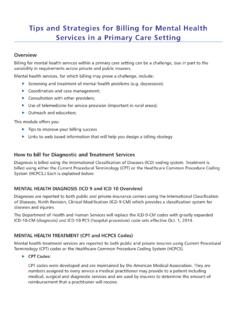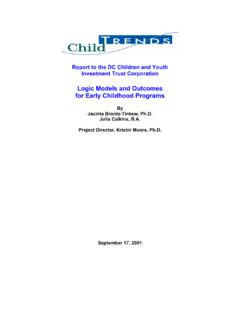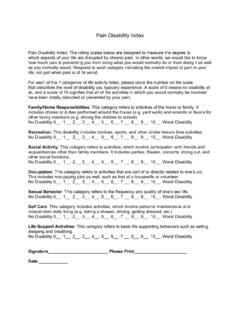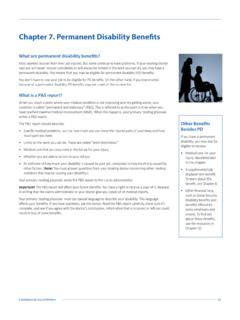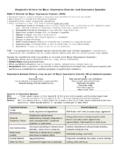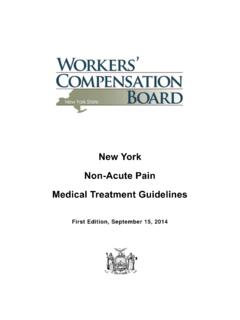Transcription of Strategies for Problem/issue prioritization
1 Strategies for Problem/issue prioritization Jan. 2019 Family Health Outcomes Project, UCSF. Jennifer Rienks, PhD & Adrienne Shatara, MPH. Overview and Objectives Discuss benefits of engaging in a more formal problem prioritization process (Reminder this is an optional process, not a requirement). Identify and outline 3 Strategies for prioritizing problems, from least to more complex Strategies Discuss pros/cons of each strategy Review 2 case studies of prioritization processes Benefits of a more Formal Problem prioritization Process Facilitates a systematic.
2 Rational and transparent decision-making process Assures a fair and inclusive decision-making process that generates priorities reflecting values and opinions of all stakeholders Assures that problems are prioritized to achieve the greatest impact on MCAH populations Identifies a manageable number of priorities Can increase stakeholder involvement and commitment to partnering to solve problems Strategies for prioritizing problems Simpler 1. Blue dot method 2. Pre-established criteria and ranking of each problem on each criteria 3.
3 Establish criteria and rating scales with stakeholders and weights for each criteria 4. Combination of the above More Complex Blue Dot Method Simplest method Process: 1. Stakeholders each given a sheet with the same number of sticky blue dots ( , 10 dots). 2. Problems/issues for prioritization are listed on a large sheet of paper attached to the wall 3. Stakeholders walk around the room and place dots on the problems they want to prioritize (can put more than one dot on a problem). 4. Problems prioritized based on number of dots received Pros/Cons of Blue Dot Method Pros Easy to explain to stakeholders and easy to do Can be done quickly Can do as part of another meeting Can have multiple groups of stakeholders prioritizing problems (or a subset of problems based on stakeholder expertise).
4 Cons Easy for stakeholders to vote for problems they are most interested in Doesn't involve the consideration of other issues ( cost of the problem, number of people impacted). Doesn't involve a discussion/consideration of values Pre-established Criteria and Ranking More complex method Process: 1. MCAH staff identify and define a small number of criteria for consideration ( , impact, severity). 2. Stakeholders given sheet of paper listing criteria and definition, and all the problems to be prioritized 3.
5 Within each criteria, stakeholders prioritize problems by assigning a number rank to each problem ( , 1-10 if prioritizing problems) with 10 being most important and 1. being least important. Within each criteria, can only use each number once. 4. Staff collect sheets and tally ranking results Pros/Cons of Pre-established Criteria and Ranking Pros Fairly easy to explain and for stakeholders to do Ranking each problem within each criteria forces stakeholders to consider each criteria and evaluate and rank each problem based on that criteria Including criteria brings a values component into the problem prioritization MCAH staff can bring their values into the process by identifying and defining the criteria.
6 And weighting criteria Cons Stakeholders can get frustrated by being forced to rank the problems Stakeholders may feel that they lack the knowledge to evaluate every problem on each criteria ( , might not understand the severity or impact of some problems). Case Study: Healthy Marin Partnership's Community Health Assessment (CHA). Healthy Marin Partnership (HMP) includes representatives from Marin's 3 local hospitals and the county health department HMP contracted with Harder+Company to conduct the CHA.
7 3 criteria selected and defined by HMP and Harder+Company HMP and Community stakeholders (approx. 50) brought in for 3 hour meeting to review data on 10 problems and then prioritize the problems by ranking on each of the criteria Harder+Company to tally results and HMP to report results to stakeholders HMP Criteria and Definitions Severity Severity of need demonstrated in data and interviews. Potential to cause death or extreme/lasting harm. County data significantly varies from state benchmarks or county goals.
8 Disparities: Health need disproportionately impacts specific geographic, age, or race/ethnic subpopulations. Impact: The ability to create positive change around this issue including . potential for prevention, addressing existing health problems, mobilizing community resources, and the ability to affect several health issues simultaneously. Weighting: Ranks for severity and impact will be multiplied by 1 for equal weighting, disparities rankings will be multiplied by since HMP is emphasizing equity in implementation strategy.
9 HMP prioritization Ballot Instructions Instructions: For each health criteria (Severity, Disparities, Impact) rank the health needs along this measure. Place numbers 1 through 10 in the column below the criteria, ensuring no repeat numbers. 10. represents the GREATEST need or ability to impact; 1. represents the least. Reflect on your small group discussion and what you learned from the large- group share-back in making your choices. NOTE: Choose the order of Assign a Assign a Assign a HMP number 1-10 in number 1-10 in number 1-10 in numbers for each of 3 criteria.
10 prioritization ( , rank the health need each box of each box of each box of this column this column this column Ballot along this measure) but NO. repeat numbers in any column. Health Need Severity Disparities Impact Access to care Economic Security Education Healthy Eating Active Living; Obesity, Diabetes, CVD, Stroke, and Cancer Housing/Homelessness Maternal and Infant Health Mental Health and Substance Use Oral Health Social Connection Violence/Injury Prevention Establishing Criteria, Scoring and Weighting with Stakeholders Complex method Process: 1.
